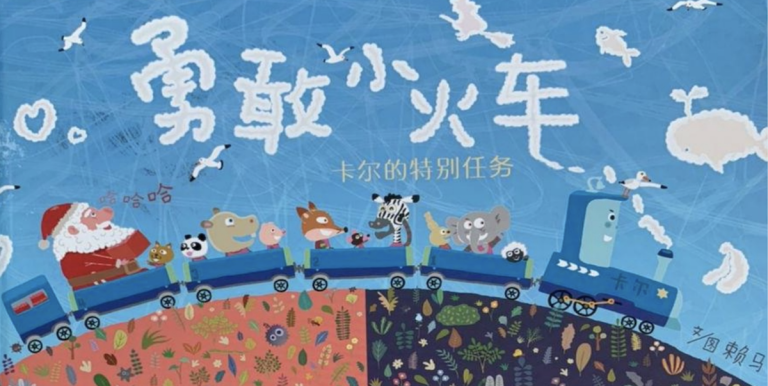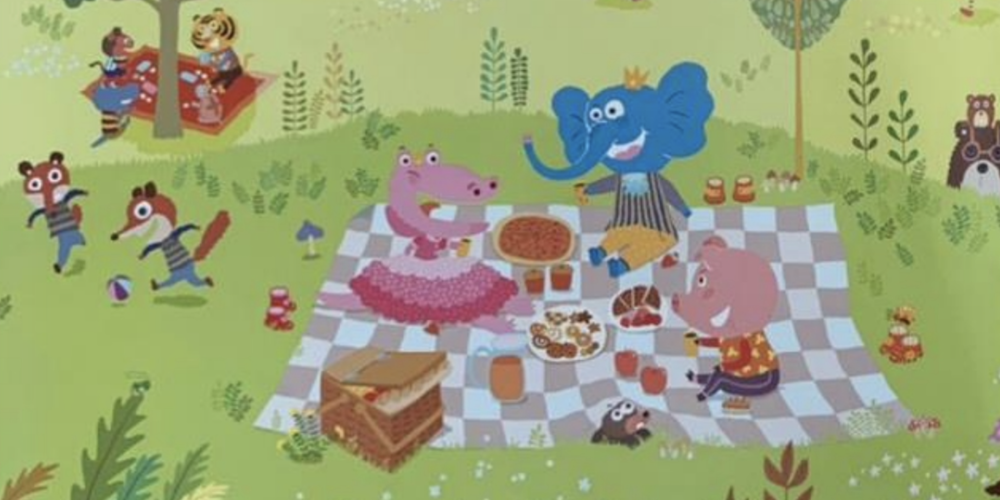

New York, N.Y. — In a quiet corner of a Brooklyn apartment, nestled between the twinkling lights of a Christmas tree and the gentle hum of a radiator, a small miracle is unfolding. A child’s small fingers carefully trace the embossed cover of a new picture book, Brave Little Train: Carl’s Special Mission.
This scene, replicated in living rooms across the U.S. represents the final stop of an extraordinary journey—one that spanned thousands of miles, from a printing press in China to the heart of the American holiday season. The book’s arrival is more than just a tale of logistics; it is a testament to the intricate, globalized dance of modern publishing and the timeless power of a simple, courageous story.
A Whimsical Tale Crosses Oceans
The story within the book’s pages is one of gentle adventure. The little train Carl has received a great mission from Santa Claus himself: to deliver gifts to the brave little animals.

This is Carl’s first time traveling to many places, and some of them are far, far away.
The narrative follows his journey through a scary forest, a dark tunnel, and across a high and long bridge, posing the central question to young readers: can he complete his mission?
Published by Hebei Education Publishing House (ISBN 978-7-5545-3513-4) and authorized by Parent-Child World Co., Ltd., this Chinese-origin story has found a surprising and welcoming audience in the West.
The physical journey of the book, however, is a saga in itself. Coordinated by Beijing Inspiration Century Books Co., Ltd., the process involved printing, shipping, and distribution on a tight seasonal schedule.
A typical print run of 50,000 copies, with a production cost of approximately US$1.50 (CN¥10.80) per unit, must be shipped via container vessels from the port of Tianjin to the West Coast, a sea voyage of about 5,800 miles (9,334 km), before being routed to distribution centers across the U.S.
This entire supply chain, from order to shelf, can take 60 to 90 days, requiring meticulous planning to ensure arrival before the Christmas rush.
The Intricate Supply Chain of Storytime
The success of this trans-Pacific literary exchange hinges on a perfectly synchronized supply chain. “The margin for error is incredibly slim,” explains an industry logistics manager who spoke on condition of anonymity. “A storm at sea, port congestion, or a customs delay can mean the difference between a book being under the tree or sitting in a warehouse until January.” The books are typically packed in pallets of 1,000 units each, with a single 40-foot container holding 20-22 pallets. The freight cost for such a container can range from US$4,000 to US$8,000 (CN¥28,800 to CN¥57,600), depending on fuel prices and shipping lane demand.
Once stateside, the books are transported by truck to major retailers and online fulfillment centers, adding another layer of cost and coordination. The final retail price of US$12.99 (CN¥93.50) must absorb these cumulative expenses while still providing a profit margin for the publisher, distributor, and retailer. This economic model, while complex, demonstrates the commercial viability of translating and importing children’s literature from Asian markets, a niche that has grown steadily over the past decade. The American publishing industry has taken note, with several major houses establishing dedicated scouts in the region.
Cultural Nuances and Universal Themes
What is the appeal of a story like Carl’s Special Mission to a Western audience? Cultural analysts point to the blend of the familiar and the slightly novel.

The tropes of a brave underdog, a mission from Santa, and anthropomorphic vehicles are instantly recognizable to children raised on The Little Engine That Could and Thomas the Tank Engine.
Yet, the artistic style, the specific cadence of the translated language, and certain narrative sensibilities offer a fresh perspective.
“There is a universality to themes of courage, perseverance, and completing a important task that transcends borders,” says Dr. Alanna Ribeiro, a professor of comparative children’s literature at the University of Michigan.
“A child in Ohio doesn’t question the origin of Carl’s journey; they connect with the emotional core—the anxiety of a first time away from home, the fear of the dark tunnel, the triumph of overcoming a challenge. The book acts as a small, powerful bridge between cultures, teaching empathy through shared experience.”
The illustrations, which often feature a softer color palette and different character designs compared to Western classics, also provide a visual diversity that many parents and educators find enriching.
The Silent Partners in Global Publishing
The journey of Brave Little Train would not be possible without the often-overlooked roles of licensing and intellectual property management. Parent-Child World Co., Ltd., as the licensor, holds the original copyright and grants specific rights to other entities. Hebei Education Publishing House manages the primary publication in the Chinese market, while the deal with Beijing Inspiration Century Books Co., Ltd. facilitates the international print run and distribution. These agreements dictate everything from royalty payments—typically 6-10% of the wholesale price—to which territories can sell the book.
This ecosystem supports a vibrant, if less visible, segment of global trade in creative goods. It allows for the flow of stories and ideas not just from West to East, which has been the historical norm, but increasingly in the opposite direction. The success of a single title can pave the way for more translations and exports, slowly diversifying the landscape of children’s literature available to American families. It is a commercial enterprise, certainly, but one with profound cultural implications.

A Story’s End is a New Beginning
As the last page of Brave Little Train: Carl’s Special Mission is turned, and a sleepy child is reassured that Carl did, indeed, complete his mission, the larger story continues. The book’s presence on a American bookshelf is a quiet marker of our interconnected world. It speaks to the efficiency of global supply chains, the business of cultural exchange, and the enduring fact that a good story, no matter its origin, can find a home anywhere. This Christmas, as Carl the train delivers his gifts to the brave animals, he has also delivered a small piece of cross-cultural understanding, proving that courage and kindness are languages every child can understand.
Kiddie Lit: A Christmas Choo-Choo from the Heart of China (Oct. 26, 2025)
Summary
A new children’s book, “Brave Little Train: Carl’s Special Mission,” has journeyed from a publisher in China to become a holiday favorite in the U.S. This feature explores the intricate global supply chain that delivers the book on time for Christmas, its cultural resonance with Western audiences, and the business of licensing that makes such cross-cultural literary exchanges possible and profitable.
#GlobalPublishing #ChildrensBooks #CulturalExchange #SupplyChain #BraveLittleTrain
#ChristmasBooks #InternationalBusiness #KidsLit #HolidayReading
TAGS: Brave Little Train, Carl’s Special Mission, Hebei Education Publishing House, global publishing, children’s literature,
supply chain logistics, Christmas books, cultural translation, intellectual property, licensing, international trade, kids books
Facebook/Instagram:
This Christmas, a little train named Carl is delivering more than just gifts—he’s bridging continents. Discover the fascinating journey of “Brave Little Train: Carl’s Special Mission,” from its origins in China to its place under American Christmas trees. Explore the story behind the story in our latest feature. #BraveLittleTrain #ChristmasBooks #GlobalPublishing #ChildrensBooks
LinkedIn:
The journey of a children’s book from a printing press in China to a retailer in the U.S. is a masterclass in global logistics and cultural business. Our latest analysis delves into the supply chain, licensing, and market dynamics behind “Brave Little Train: Carl’s Special Mission,” highlighting a growing trend in trans-Pacific publishing. A compelling read for professionals in publishing, logistics, and international trade. #Publishing #SupplyChain #InternationalBusiness #Globalization
X/Twitter/BlueSky:
How does a Chinese children’s book become a Christmas hit in the U.S.? From Santa’s mission to a 5,800-mile supply chain, we unpack the journey of “Brave Little Train: Carl’s Special Mission.” The global business of storytime is more complex than you think. #KidsLit #GlobalPublishing #SupplyChain #Christmas